MKMapView and Zoom Levels: A Visual Guide
原帖:http://troybrant.net/blog/2010/01/mkmapview-and-zoom-levels-a-visual-guide/
So, how exactly does the code provided in the previous post work? What follows is a visual explanation of Google Maps, zoom levels, and how you go about adding support for zoom levels to the MKMapView class.
Round to Flat
This is planet Earth:
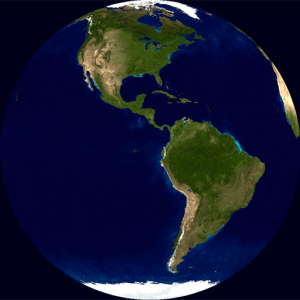
As you may know, it is round.
To create a map of the Earth, the curved surface must be projected onto a flat surface. There are many map projections that attempt to flatten the Earth. There are distortions inherent to every projection, but each map projection aims to preserve at least one quality from the original curved representation.
Some projections preserve area, such as the Mollweide projection:
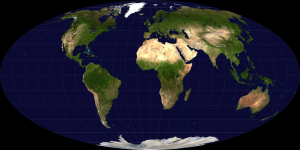
Equirectangluar projections preserve distance between the meridians:
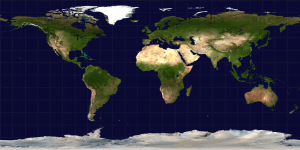
The Mercator projection stretches out the poles in order to preserve locally measured angles:
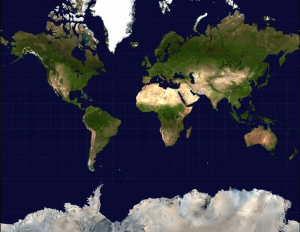
Google uses the Mercator projection to render Google Maps:
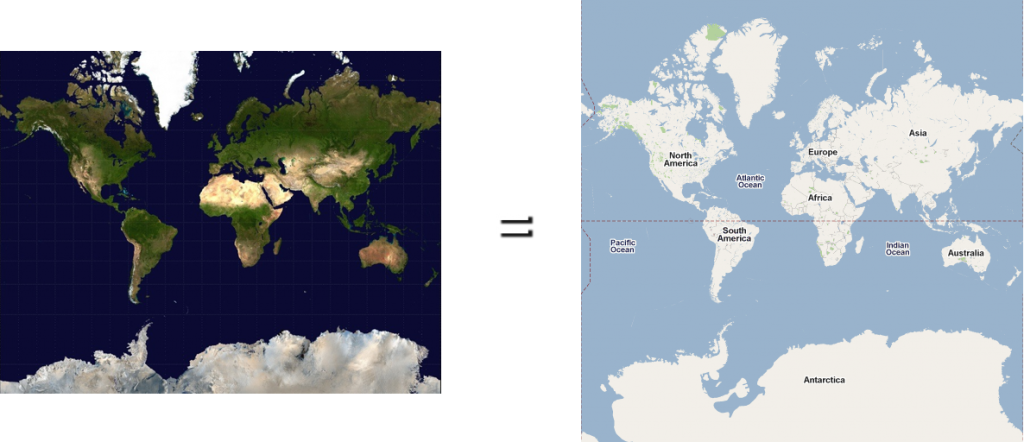
Mercator Math
The Mercator projection converts latitude (φ) and longitude (λ) coordinates to pixel values. It uses math:

You don’t have to understand the math; just know that it converts latitudes and longitudes to pixels.
But, where are these pixels? Well, it depends on your zoom level.
Zoom Levels
At zoom level 0, Google displays the world in a single 256 pixel by 256 pixel tile:

At zoom level 1, Google doubles the area of the map while keeping the tile size constant. So, the map grows to 512 pixels by 512 pixels and uses four tiles:

At zoom level 2, Google doubles the area again. The map grows to 1024 pixels by 1024 pixels and uses sixteen tiles:

The pixel area continues to double at each zoom level, and when zoom level 20 is reached, the map is 536,870,912 pixels by 536,870,912 pixels. It has so many tiles we won’t bother to count them:
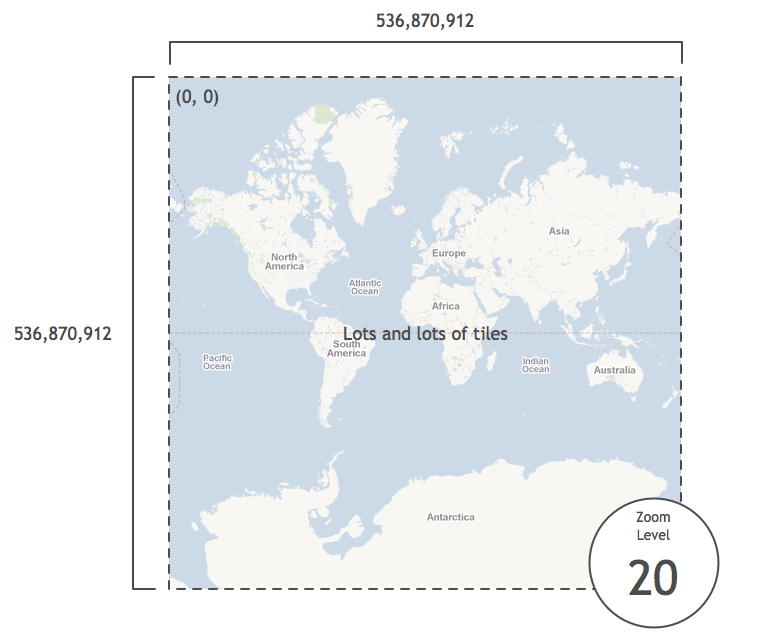
Latitudes and Longitudes to Pixels
As part of the PHP Static Maps project, Mike Tuupola wrote some code that converts latitudes and longitudes to pixels at zoom level 20. The code is easily ported to Objective-C:
#define MERCATOR_OFFSET 268435456 /* (total pixels at zoom level 20) / 2 */
#define MERCATOR_RADIUS 85445659.44705395 /* MERCATOR_OFFSET / pi */
x = round(MERCATOR_OFFSET + MERCATOR_RADIUS * longitude * M_PI / 180.0);
y = round(MERCATOR_OFFSET - MERCATOR_RADIUS * logf((1 + sinf(latitude * M_PI / 180.0)) / (1 - sinf(latitude * M_PI / 180.0))) / 2.0);
To be honest, I haven’t taken the time to wrap my head around how this code works. But, knowing that it does
work, we can now take any latitude and longitude and figure out its
pixel coordinates at zoom level 20. For instance, here are the pixel
coordinates of several cities around the world:
![]()
Add an iPhone
Say we place an iPhone on top of Anchorage, Alaska at zoom level 20:

In the iPhone shown above, the map size is 320 pixels by 460 pixels.
Since we know the map dimensions and center coordinate in pixels, we can
easily compute the pixel coordinates of the top-left corner relative to
the center pixel coordinate:

We can find the relative position of the top-right and bottom-left pixel coordinates as well:

The PHP Static Maps code also provides code to go from pixels at zoom level 20 to latitudes and longitudes:
latitude = (M_PI / 2.0 - 2.0 * atan(exp((round(pixelY) - MERCATOR_OFFSET) / MERCATOR_RADIUS))) * 180.0 / M_PI;
longitude = ((round(pixelX) - MERCATOR_OFFSET) / MERCATOR_RADIUS) * 180.0 / M_PI;
We can use this code to convert the corners from pixel coordinates to latitudes and longitudes:
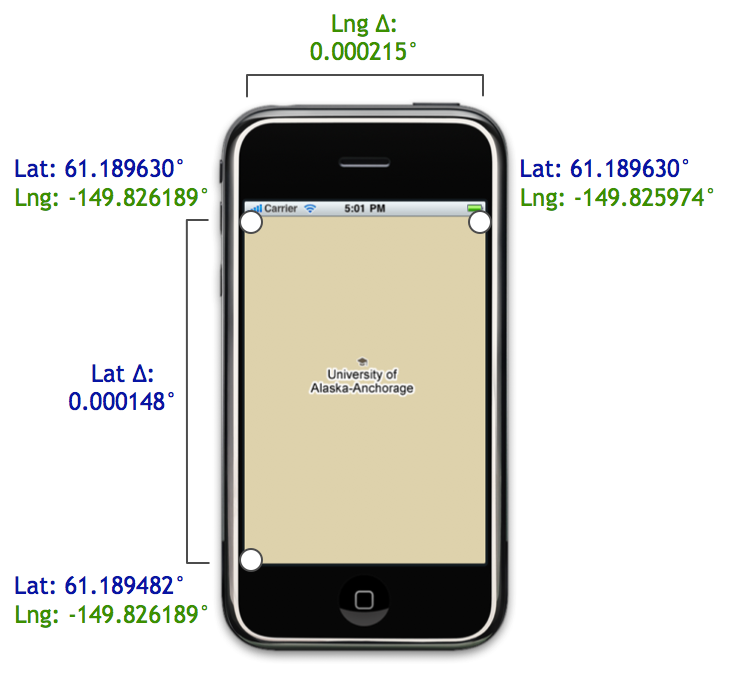
As shown above, using the corner coordinates, we can compute the
latitudinal and longitudinal distances. These distances are exactly what
we need to construct an MKCoordinateSpan. That span, in turn, is used to initialize the region property of an MKMapView:
MKCoordinateSpan span = MKCoordinateSpanMake(latitudeDelta, longitudeDelta);
MKCoordinateRegion region = MKCoordinateRegionMake(centerCoordinate, span);
[mapView setRegion:region animated:NO];
And you’re done!…That is, if you want to see zoom level 20. What do
you do when your user wants to see the map at zoom level 19 instead of
20?
Scaling using Zoom Levels
Relative to zoom level 20, zooming out one level doubles the area visible on the map.
For example, consider the image below. On the left is Anchorage at
zoom level 19, and on the right are the 4 iPhones at zoom level 20 it
would take to display the same amount of area:
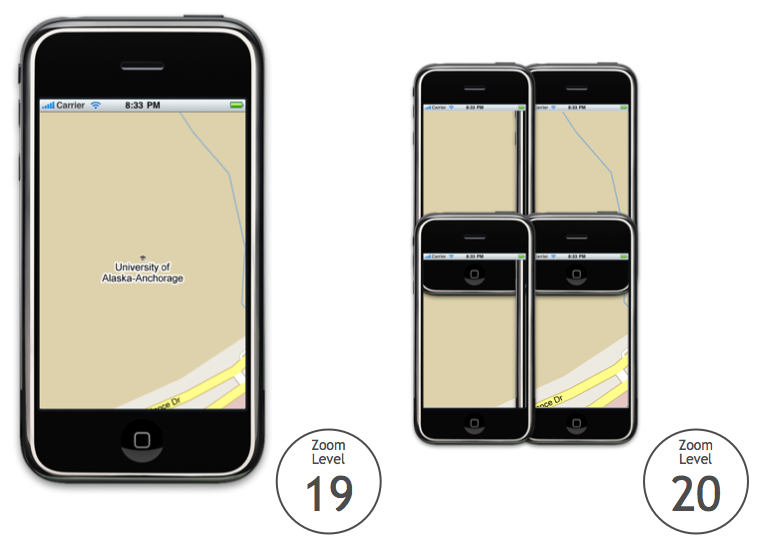
If we move up another level, the area doubles again. Consider the
following image. On the left is Anchorage at zoom level 18, and on the
right are the 16 iPhones at zoom level 20 it would take to display the
same amount of area:
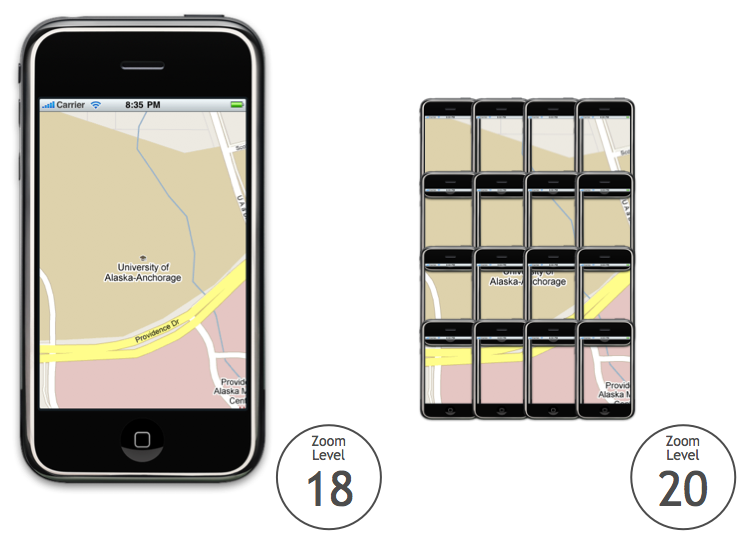
Since the area doubles at each zoom level, we can define the
following exponential relationship between the zoom level and the area
covered by the map:
NSInteger zoomExponent = 20 - zoomLevel;
double zoomScale = pow(2, zoomExponent);
double scaledMapWidth = mapSizeInPixels.width * zoomScale;
double scaledMapHeight = mapSizeInPixels.height * zoomScale;
For instance, here is Anchorage at zoom levels 20, 19, and 18. The map’s width and height in pixels are unaltered:
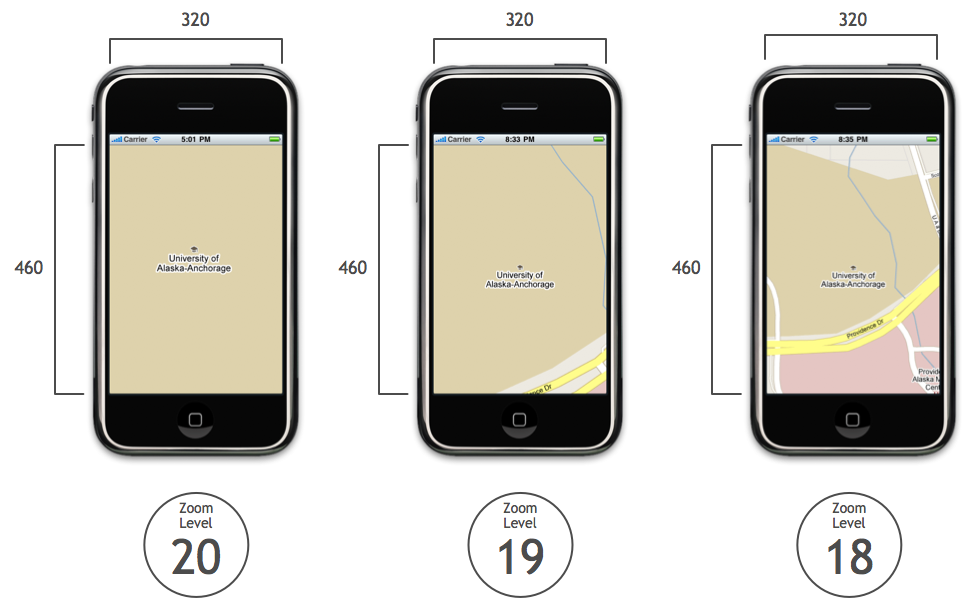
After computing the zoom scale factor, we can apply it to each map to determine its dimensions at zoom level 20:

After we compute these new dimensions, we plug them into the algorithm for finding the coordinates of the map corners.
An Example: Zoom Level 18
For instance, say we take the map at zoom level 18:
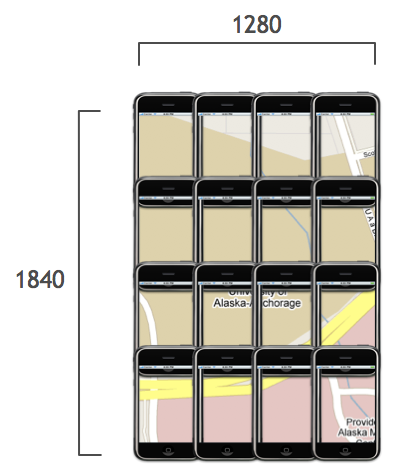
Let’s drop the matrix of phones but keep the scaled width and height:
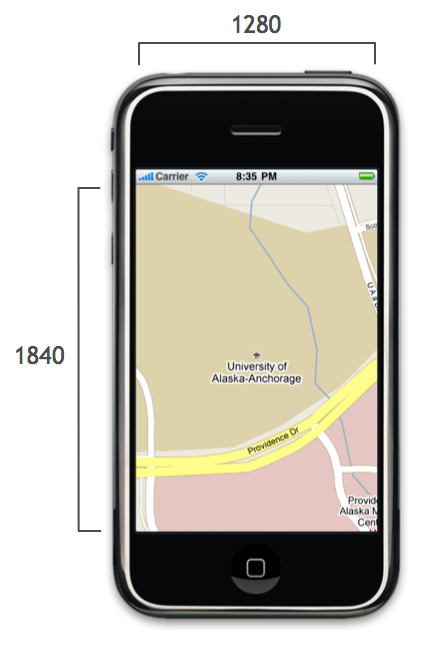
We find the top-left corner just like we did before, except now we use the scaled width and height:

Similarly, we use the scaled width and height for finding the top-right and bottom-left corners as well:

Using the pixel and latitude and pixel and longitude helper methods,
we can compute the coordinates of the corners and the distance between
them:
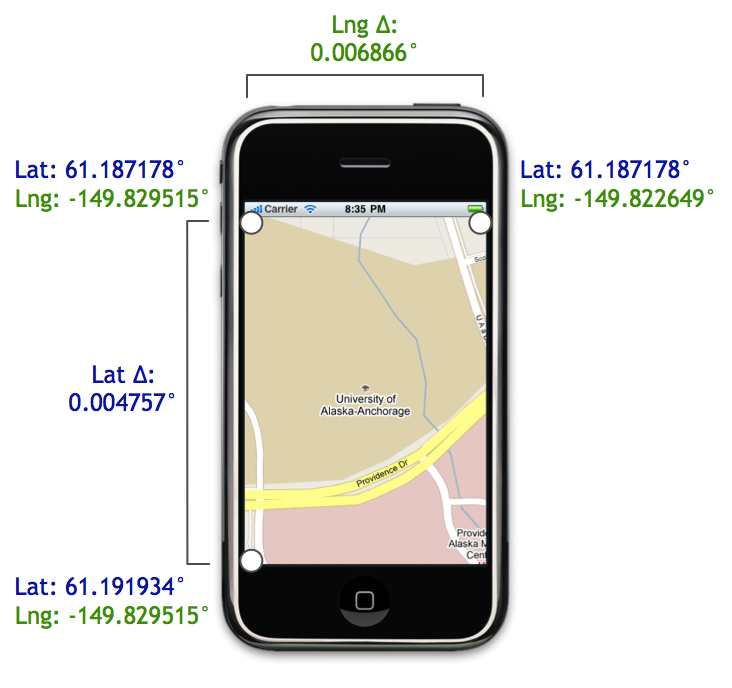
These delta values are used to initialize the map’s region property, and the map zooms to the level you specify.
That’s a Wrap
Be sure to check out the previous post for the full code that adds support for zoom levels to MKMapView.
If you are interested in learning more from someone much smarter than I am, check out these posts from Charlie Savage, a programmer and cartographer extraordinaire:
Much of what I know about maps is from these articles, and I highly
recommended checking them out if you want to learn more about how Google
Maps works under the hood.
MKMapView and Zoom Levels: A Visual Guide的更多相关文章
- [Forward]Visual Guide: Setting up My Sites in SharePoint 2013
from http://blog.sharedove.com/adisjugo/index.php/2012/07/25/visual-guide-setting-up-my-sites-in-sh ...
- A SIMPLE LIBRARY TO BUILD A DEEP ZOOM IMAGE
My current project requires a lot of work with Deep Zoom images. We recently received some very high ...
- leaflet地图库
an open-source JavaScript libraryfor mobile-friendly interactive maps Overview Tutorials Docs Downlo ...
- Android Weekly Notes Issue #221
Android Weekly Issue #221 September 4th, 2016 Android Weekly Issue #221 ARTICLES & TUTORIALS And ...
- less 基础+ flex
1.less 中的变量 @ 符号 引入 /*普通变量*/ @color:pinker; .styles{ color:@color; } /*选择器变量*/ @I:img; @{I}{ width: ...
- Flex 布局教程:语法篇
作者: 阮一峰 网页布局(layout)是CSS的一个重点应用. 布局的传统解决方案,基于盒状模型,依赖 display属性 + position属性 + float属性.它对于那些特殊布局非常不方便 ...
- TileJSON
TileJSON TileJSON is an open standard for representing map metadata. License The text of this specif ...
- MBTiles
MBTiles Specification MBTiles is a specification for storing tiled map data in SQLite databases for ...
- 【转】Flex 布局语法教程
网页布局(layout)是CSS的一个重点应用. 布局的传统解决方案,基于盒状模型,依赖 display属性 + position属性 + float属性.它对于那些特殊布局非常不方便,比如,垂直居中 ...
随机推荐
- 关于虚拟继承类的大小问题探索,VC++ 和 G++ 结果是有区别的
昨天笔试遇到个 关于类占用的空间大小的问题,以前没怎么重视,回来做个试验,还真发现了问题,以后各位笔试考官门,出题时请注明是用什么编译器. vc6/vc8 cl 和 Dev-C 的g++ 来做的测试: ...
- Sql 语句添加字段、修改字段类型、默认值语法
Sql 语句添加字段 ,) not null --修改类型 alter Table bbs ) Sql 语句修改默认值 alter table 表名 drop constraint 约束名字 --删除 ...
- jquery跳出当前的each循环
break----用return false; continue --用return ture; jquery是对象链,所以$(..).each()返回的还是对象集合.each(function(){ ...
- HDU -2546饭卡(01背包+贪心)
这道题有个小小的坎,就是低于5块不能选,大于5块,可以任意选,所以就在初始条件判断一下剩余钱数,然后如果大于5的话,这时候就要用到贪心的思想,只要大于等于5,先找最大的那个,然后剩下的再去用背包去选择 ...
- php微信接口验证写法
<?php //获得接口认证 $timestamp = $_GET['timestamp']; $nonce = $_GET['nonce']; $token = 'weixin'; $sign ...
- MySQL TEXT数据类型的最大长度
TINYTEXT 256 bytes TEXT 65,535 bytes ~64kb MEDIUMTEXT 16,777,215 bytes ~16MB LONGTEXT 4,294,967,2 ...
- (转)select 1 from ... sql语句中的1代表什么意思? .
select 1 from ..., sql语句中的1代表什么意思?查出来是个什么结果? select 1 from table;与select anycol(目的表集合中的任意一行 ...
- 破解Windows Server 2003只允许3个用户远程登陆
导读:WIN2003在使用远程桌面登录的时候,一台机器默认情况下只允许3个用户同时登录. 这很不方便.我们修改WIN2003远程桌面的连接数,可以设置3个以上用户远程桌面. 1.启动终端服务:在&qu ...
- CMD 下 进入 ORACLE
.sqlplus /nolog .connect sys/orcl@ORCL as sysdba .select sysdate from dual exit;
- Python交互模式下方向键出现乱码
解决办法如下: 1.安装readline模块 readline库是bash shell用的库,包含许多功能,如命令行自动补全等. ubuntu下安装的命令: sudo apt-get instal ...
